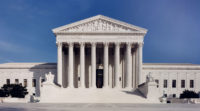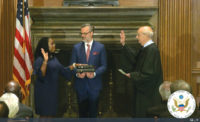The U.S. Supreme Court’s decision to hear a challenge by Idaho landowners of a government ruling that they could not build a residence on land deemed as wetlands could signal justices' willingness to impose a more limited view of environmental protections under the U.S. Clean Water Act, sources familiar with the case suggest.
The nation’s top court agreed on Jan. 24 to consider whether a lower court used the correct test to determine that Michael and Chantelle Sackett could not legally challenge a U.S. Environmental Protection Agency decision barring them from building the home on property that contained wetlands.
The new case marks the second time the Sacketts, represented by the Pacific Legal Foundation, have appeared before the Supreme Court. In 2012, justices unanimously ruled in their favor, concluding the couple had the right to legally protest EPA’s threat of a fine if they built on their property.
The question of how to define federally protected water bodies, so-called “waters of the United States” (WOTUS), has been debated for decades. Under the federal clean water law, builders must obtain a permit from the U.S. Army Corps of Engineers to remove or build near wetlands that are close to federally protected bodies of water.
Earlier Cases
In 2006, the Supreme Court handed down a split 4-1-4 ruling in Rapanos v. EPA that established two different tests to identify waters that fall under the law’s protection. One outlined by Justice Anthony Kennedy said wetlands that have a “significant nexus” to navigable waters fall under federal jurisdiction. Justice Antonin Scalia provided a more limited test, based on whether the wetlands had an actual connection to flowing surface waters.
In 2015, during the Obama administration, EPA used the Kennedy test as the basis for its Clean Water rule, which environmental groups favored, but construction and industry groups did not.
In 2020, the Trump administration released the Navigable Waters Protection Rule, which relied more on the Scalia test and excluded ephemeral and intermittent streams, as well as headwaters, from the scope of federal jurisdiction.
In 2021, under President Joe Biden, EPA proposed revoking the 2020 rule, with public comment set to end Feb. 7. The agency also said it plans to propose a new WOTUS rule that would clarify current confusion and would withstand potential legal challenges.
In the interim, EPA has resumed its stance taken prior to its release of the 2015 Obama-era Clean Water rule.
A new Supreme Court decision that relies more on the Scalia test could prove problematic for EPA, says Larry Liebesman, senior adviser at Dawson & Associates, a Washington, D.C.-based water-resources consulting firm.
Ruling Ramifications
“It’s a conservative court,” with at least four justices who might support a more narrow definition, notes Liebesman, a former litigator in the U.S Justice Dept.'s Environment Division.
If that were to happen, EPA “would have to redo the rule,” he says. Given the court’s full docket for the rest of this term, which usually ends by early July, it might not take up the clean water case until next year, he notes.
Whether Justice Stephen Breyer weighs in on the case with a broader WOTUS definition now depends on how quickly the court hears arguments, with his just announced retirement at the end of the current term. A successor may instead join the ruling, if arguments are not scheduled until the fall.
Breyer was one of the four dissenting justices led by former Justice John Paul Stevens in the 2006 Rapanos case who said the wetlands at issue fell under the federal clean water law, and also wrote a separate dissent urging U.S. action.
More recently, in a dispute related to the law's application to indirect pollution from a Maui, Hawaii, wastewater treatment plant traveling through groundwater, he wrote the court's 2020 6-3 opinion that the act does have jurisdiction but left unclear specific permitting requirements.
The American Water Works Association, which represents 4,500 drinking water utilities, asked EPA Administrator Michael Regan in a Jan. 28 letter not to issue the new WOTUS rule until the court ruling on the Sackett case. The group said that action would "greatly reduce wasted and duplicated effort on the part of EPA and the entire stakeholder community, reduce regulatory whiplash, and to greatly increase the chances of the final definition being sustainable (whether that means remaining at the pre-2015 rules or a new definition).”
Environmental Group, Home Builders Views
John Rumpler, clean water program director at Environment America, says he cannot predict what the court will do but adds that established science, and the language of the law itself, support a broader definition.
“If you look at the language in the Clean Water Act, it clearly states that its purpose is to maintain and protect the biological, chemical and physical integrity of the nation’s waters," he says. "You simply cannot do that without protecting wetlands and these intermittent and ephemeral streams.”
Thomas Ward, vice president of legal advocacy for the National Association of Home Builders, which has filed a brief supporting the Sacketts’ position, says he hopes the court will provide more certainty to builders.
Ward says that he question of whether land falls under federal Clean Water Act jurisdiction is significant for home builders nationwide because of costs associated with obtaining a federal permit.
Rumpler says the high court's decision will be important. “What’s really at stake in these cases is the fate of wetlands and streams that do not run year round,” he says.
EPA has estimated that, collectively, intermittent and ephemeral streams, and headwaters, provide drinking water to 117 million Americans. “That’s why those streams matter,” Rumpler says.




1.png?height=200&t=1649440578&width=200)

Post a comment to this article
Report Abusive Comment